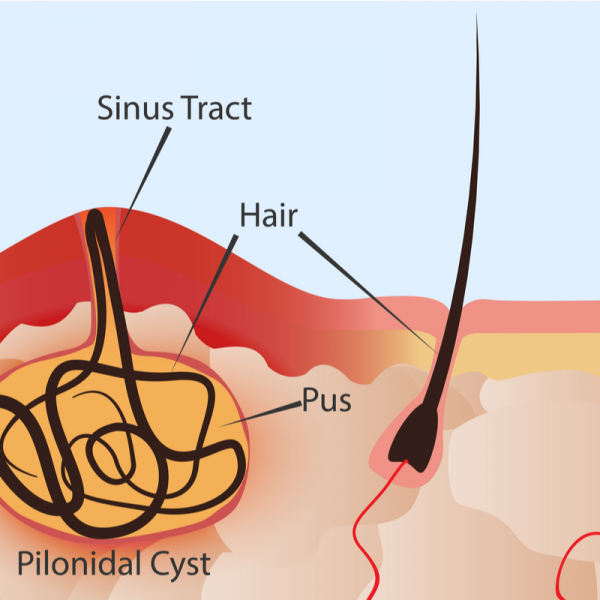
What is a pilonidal cyst?
A pilonidal cyst, or sinus pilonidalis, is derived from the Latin word "pilus", which means hair. A pilonidal cyst is therefore also an inflammation of the hair and sebaceous gland follicles, which develop at the midline of the back, the exit of the buttock fold, and form an abscess there over time. The vernacular therefore also speaks of a coccygeal fistula. A pilonidal cyst is not always easy to treat and has a relatively high probability of recurrence. Young adults between the ages of 15 and 30 are more likely than average
todevelop
a pilonidal cyst, and men are more likely than women to be affected.
What causes a pilonidal cyst to develop?
A pilonidal cyst develops after puberty, because during this phase there is an increased release of sex hormones that stimulate hair growth and sebum production. Since the pilonidal cyst grows in a narrow skin fold, this favours the development of local inflammations and abscesses. In addition, this area of the skin is often irritated by excessive sweat production, which causes the glands to swell and the sebum can no longer be completely emptied. This leads to gland inflammation and the formation of a small abscess. Doctors do not rule out the possibility that a genetic predisposition can also play a role in the development of a pilonidal cyst.
What are the symptoms of a pilonidal cyst?
A pilonidal cyst can initially make the affected area more sensitive to pressure. Over time, this may be followed by signs of infection, such as swelling, redness and/or local warmth. Sometimes the abscess may also burst and a secretion may come out of the fistula opening. If the inflammation is not treated adequately, the pilonidal cyst will recur.
How is a pilonidal cyst diagnosed?
A pilonidal cyst may be visible externally by inflammatory changes and a fistula opening in the upper fold of the buttock.
How is a pilonidal cyst treated?
If the pilonidal cyst is asymptomatic, the cyst should only be observed. If, on the other hand, the cyst causes symptoms, a long-term cure can only be achieved by surgically removing the pilonidal cyst. After the successful removal of the cyst, the wound should be cleaned during daily showering and hair in the affected area should be shaved so that it does not get into the healing wound
.What is the prognosis for a pilonidal cyst?
In 20 percent of all patients, the pilonidal cyst returns, even after successful removal. This is particularly common if the cyst was not removed but the abscess was drained. The disease heals on its own with above-average frequency after the age of 40.
Pilonidal cyst frequencies
a|
Pathogen |
Source |
Frequencies |
|
Pilonidal cyst |
EDTFL |
180 | 490 | 720 | 950 | 95500 | 175330 | 327150 | 527000 | 634000 | 762400 |
|
Popliteal system |
EDTFL |
120 | 480 | 780 | 12500 | 43000 | 122500 | 262300 | 555340 |692500 | 819340 |
